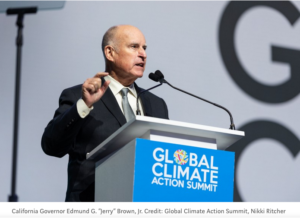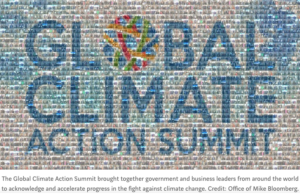GCAS: An Impossible Account of an Incredible Week (Part I)
Most people think climate change has to be solved only by national governments and the United Nations. But over the past 25 years, as national governments have struggled and often failed to address climate change adequately, it has been so-called sub-national leaders who have moved fastest to pilot ways forward. Local, regional, and corporate decision makers have often been able to move faster and more ambitiously than national governments; never more so than during the past three years since Paris. Today there are thousands of these leaders showing the way forward, sharing lessons, developing expertise, and building broader confidence that this work can be done and that it brings benefits.
Recognizing this and hoping to accelerate implementation of the Paris Climate Accord, California — one of the globe’s most important sub-national leaders — decided to host a confab for other sub-national leaders in September 2018.

California Governor Edmund G. “Jerry” Brown, Jr. Credit: Global Climate Action Summit, Nikki Ritcher Photography. www.flickr.com/photos/155996633@N08/29826140937
The Global Climate Action Summit (GCAS) in San Francisco was the first global climate meeting blessed by the United Nations for leaders who aren’t presidents and prime ministers.
Instead, it targeted mayors, governors, CEOs, and investors. These leaders have consistently been the source of the boldest and most innovative work on climate: encouraging, nudging, and even guilting national leaders and multilateral negotiators into accelerating commitments to action. By design, GCAS became a magnet for sub-national leaders to make exciting announcements and commitments.
Handing these leaders their own stage for a week was a stroke of genius that propelled forward a tsunami of animated moves in more than 350 affiliated venues in and around San Francisco. These announcements galvanized additional pledges by stoking friendly competition and by building confidence that practical and economically beneficial steps, beta-tested by local leaders and innovators, can be taken by all levels of government to solve the climate crisis.
If you were in San Francisco for Governor Jerry Brown’s GCAS week in early September, you could have heard hundreds of mayors, governors, CEOs, and investors announcing steps they are taking to pull climate change-causing emissions out of their states, cities, companies, buildings, cars, electricity, waste streams, and portfolios, and from forests and oceans. GCAS was the heart of a multi-week catchment period for hundreds of commitments and announcements made before, during, and after the formal summit.
In a series of posts, I have attempted to catalogue the announcements and commitments made around GCAS. In the 2nd post, I look at the major players making these commitments. In the 3rd post, I describe where the commitments are happening on the sub-national landscape through a sectoral lens. Below, in the 4th post, I consider how current progress can accelerate future work to put the Paris Climate Accord into full effect for 2020 and beyond.
In the post-Paris world, filled with bottom-up and largely voluntary commitment making, we need to find a better way of reporting on everything that is happening. Because there is no compliance requirement, reporting is voluntary and spotty, which makes it difficult to track. It is difficult — impossible, maybe — to piece together the full GCAS story. But even the inadequate accounting in the posts to follow reveals a surprising breadth and depth of climate actions being planned and implemented.
GCAS: The Road Ahead (Part IV)
The amount of ambitious activity underway at the sub-national level around the world is astonishing, and it is so much more vibrant, enthusiastic, and entrepreneurial than what we see happening at the national and international level.

The Global Climate Action Summit brought together government and business leaders from around the world to acknowledge and accelerate progress in the fight against climate change. Credit: Office of Mike Bloomberg. www.flickr.com/photos/mikebloomberg/44659660701
President Trump, ironically, may have helped boost this beehive of sub-national urgency with his misguided decision to pull out of the Paris Climate Accords. Sub-national action has been a constant through the two and a half decades that the world has been seriously grappling with climate change, but after 25 years of incremental experimentation since the 1992 Rio Summit, there has been a sudden upturn of action and ambition. For those who witnessed GCAS and its reverberations across cities, states, and companies, this surge of action and seriousness was readily apparent.
What is especially heartening is the degree of ambition of the policy moves. They have gone beyond incremental and finally reached a level that is commensurate with what scientists say is necessary. Zero-carbon buildings, 100 percent clean transportation, 100 percent renewable electricity, zero waste: This family of commitments made by sub-national leaders, as spelled out in prior sections of this series, are what is needed at all levels of government, including the national level.
For many reasons, national governments have to date found it difficult to commit to the dramatic changes required to solve the climate crisis. Their domains are often too vast and their citizens’ interests too varied to find political support for things like radically transforming electricity supply or moving transportation systems away from fossil fuel-driven infrastructure. Entrenched utility and fossil fuel sector interest groups with political punch, like the Koch Brothers in the United States, can band together around status quo positions to effectively contest new policy directions that threaten their financial interests.
For more than 25 years, democratic national governments have struggled to get past these domestic constituencies to do the really big things necessary on climate. When nations have occasionally been able to stake out an ambitious leadership position, they have often been forced to retract those commitments over time after the election of a new government from an opposing party. Australia, Canada, the United Kingdom, and the United States come to mind as examples of countries experiencing a roller coaster of climate policymaking. Driving these reversals are claims of economic calamity and a basic unease about a future that is hard to visualize.
As a result, policy action at a federal level has often been, by necessity, incremental. Compromise and the need to appear reasonable drive outcomes that don’t get the job done with the speed and urgency required.
By contrast, cities, states, and companies can often move more boldly on climate change solutions that promise a radical non-carbon approach. Strong executives at the sub-national level with more circumscribed jurisdictions and constituencies can more easily sell an approach that is visionary, overcomes fear, and gets the job done with the necessary speed.
As seen in the commitments catalogued in this series, a remarkable evolution in commitment making, policymaking, and overall leadership has unfolded at the city, state, and corporate levels, offering some hope that dramatic change is possible.
The breadth of action now documented and systematized in how-to manuals and playbooks like the RMI city (Note 1) and state (Note 2) handbooks and the C40-McKinsey Focused Acceleration report (Note 3) represents a remarkable step up by sustainability directors embedded in governments and companies around the globe.
Powering the spread of best practice from city to city, state to state, and company to company are a small number of “high ambition coalitions” like C40, the Carbon Neutral Cities Alliance, the Under2 Coalition, the RE100 network, and We Mean Business, who are working to help more and more cities, states, and companies comprehend and engineer carbon-reducing mechanisms for their own use.
There is so much happening that it is more and more difficult to keep track. The crescendo of commitments and announcements in and around California during August-November of 2018 is overwhelming.
To evaluate the intensity of commitment and action, The Climate Group and the Carbon Disclosure Project (Note 4) tracked nearly 200 cities, states, and companies, who had made high ambition commitments (80 percent carbon emission reductions or better by 2050) just before the Paris COP in December of 2015. At the time, this was a very exciting ratcheting up of ambition by sub-nationals; there had only been a few handfuls of such high ambition commitments three years before in 2012. Today, three years after Paris, there are nearly 1,000 high ambition city, state, and company commitments. About half are from business and half are from cities and states around the world.
Because these pledges have been spread out geographically, it hasn’t been immediately obvious, but looking across the full span of these local and regional governments and companies, it is clear that the trajectory of adoption has gone nearly exponential in a very short time span.
As “advanced class” sub-nationals move to adoption and implementation, others are more likely to follow. Sub-national leaders can also inspire national level policymakers and multilateral negotiators to accelerate their commitments with real world examples of effective action.
Though nation states have been slower to the high ambition bar, there is an insistent trickle of high ambition national level pledges that appears to be speeding up as we approach the 26th session of the Conference of the Parties to the United Nations Framework Convention on Climate Change (COP26) at the end of 2020. In the coming two years, we need many more nation states to ratchet up their climate ambition if we’re going to get to the 1.5-degree warming ceiling that scientists say is necessary to give us a fighting chance of preserving a livable planet.
The massive uptick in sub-national high ambition targets is important leverage to getting those national level commitments. Sub-nationals offer examples and proof that it can be done, and they show the way forward with empirical experience and tested policy models. They also help show that these steps can be attractive and economically beneficial. Job generation, economic growth, quality of life, and health outcomes all improve with these transformative changes. For most of us, this new world is not one to fear; it is one to aspire to. That is becoming evident as more and more jurisdictions and companies move forward with successful transformation.
Also aiding this growing wave of action is the improving economics of cost competitive renewables and other clean energy technologies. Twenty years ago, clean energy prices were high, and it was thought a price on carbon was the way to level the playing field to spur competition with low-cost fossil fuels. As time has marched forward without needed action on carbon pricing, the playing field is leveling because of the cost reductions associated with maturing clean energy technologies. (Although carbon pricing would still be enormously helpful as an accelerant for more rapid and deep action.)
Urgency is an important spur to the progress we are witnessing. The science is dire. The UN Intergovernmental Panel on Climate Change (IPCC) announced on October 7 that the world has a decade to get it right or risk an unstoppable cascade of negative impacts from runaway climate change.
Anyone who has read the recent IPCC report is worried. As a result, more employees and citizens are insisting on action, and leaders are getting into the fray. The U.S. National Assessment released on November 23 paints a similarly stark picture of the economic damage that will result if we don’t ratchet up climate action quickly.

Credit: Global Climate Action Summit, Nikki Ritcher Photography. www.flickr.com/photos/155996633@N08/42929660580/
Given the energy and creativity evident in and around San Francisco in September and the near daily announcements since, there does appear to be a slim measure of hope that we can recruit the national level commitments we need for COP26 in Milan. We seem to be moving very last minute on something intensely serious, but, just maybe, all of the remarkable progress and potential on display around the California summit will piece itself together and leverage additional national level commitments to create a global solution big enough to rescue our children and their children from a hellish future existence.
Note 1. Rocky Mountain Institute, The Carbon-Free City Handbook (2017). bit.ly/2C8qPwk
Note 2. By Jacob Corvidae, Laurie Stone, Matt Jungclaus, James Mandel, Angela Whitney, Peter Bronski, The Carbon-Free Regions Handbook (2018). bit.ly/2zWXcg5
Note 3. McKinsey Center for Business and Environment, Focused acceleration: A strategic approach to climate action in cities to 2030 (November 2017). mck.co/2IAai4e
Note 4. The Climate Group and the Carbon Disclosure Project, Unlocking ambition: top corporate and sub-national climate commitments bit.ly/2QN4D2Z
Michael Northrop is Director of the Sustainable Development Program at the Rockefeller Brothers Fund. The entire four-part GCAS post can be found at medium.com/global-climate-action-summit-an-impossible-account



No comments yet, add your own below